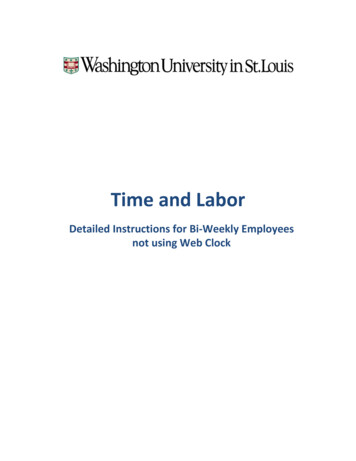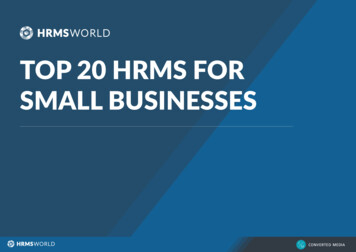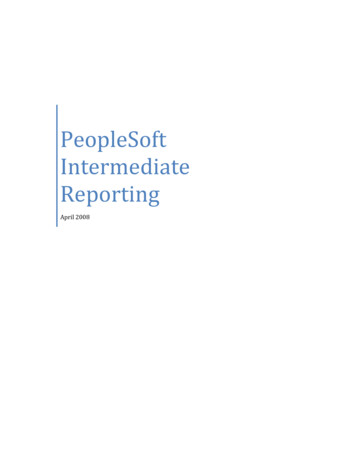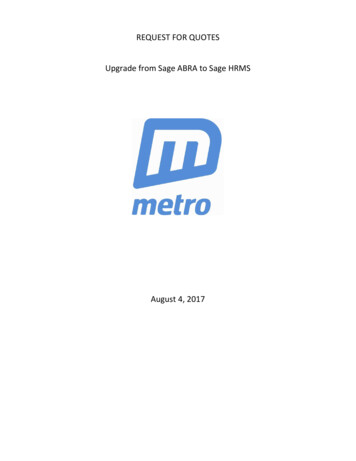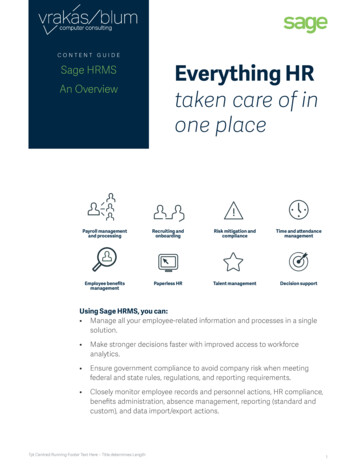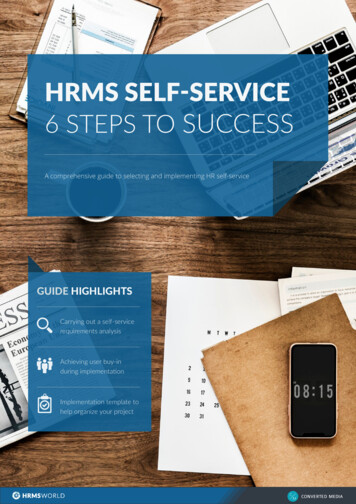
Transcription
HRMS SELF-SERVICE6 STEPS TO SUCCESSA comprehensive guide to selecting and implementing HR self-serviceGUIDE HIGHLIGHTSCarrying out a self-servicerequirements analysisAchieving user buy-induring implementationImplementation template tohelp organize your projectCMCONVERTED MEDIA
INDEX3Introduction4Identify desired self-service outcomes6Carry out an HR self-service requirements analysis9Ensure user buy-in for your new system11Engage managers with self-service13Tailor training to your workforce16Fully implement your HRMS self-service solution18HR self-service implementation templateHRMS self-service: 6 steps to successPage 2CMCONVERTED MEDIA
“On the face of it, this is a large undertaking for a companyof any size, but in the end the benefits usually outweigh theimplementation costs.”Whether your company is an SME employing 20 staff or a global conglomeratewith employees numbering in the thousands, the benefits of an HRMS withself-service functionality are extensive. However, as with any enterprisesoftware implementation, self-service functionality is not as simple as ‘plugand play’.In order to achieve success with HRMS self-service, your company mustunderstand its advantages and limitations, requirements and functions, andultimately, the compatibility of self-service with your HR department andbusiness as a whole. A self-service HRMS will open up data and processes toemployees company-wide, resulting in a need for in-depth process analysis,mass user adoption and training. On the face of it, this is a large undertakingfor a company of any size, but in the end the benefits usually outweigh theimplementation costs.This whitepaper addresses all areas of HRMS self-service; defining the benefits,developing selection and implementation strategies, achieving employee andmanager engagement as well as planning user training. Together, these formthe ultimate 6 step guide to HRMS self-service success.HRMS self-service: 6 steps to successPage 3CMCONVERTED MEDIA
IDENTIFY DESIRED HR SELF-SERVICE OUTCOMESTechnology is all about streamlining procedures,saving time and achieving more with fewer resources.When it comes to the endless detailed queries ouremployees have about terms, conditions, salary, leaveentitlement, and so on, the days of turning to the HR“ The rise of HRMS and payrollsystems with self-servicefunctionality have largelyremoved the HR middle-man”department for answers are almost done.The continuing rise of automated HRMS and payroll systems with self-service functionality havelargely removed the HR middle-man/woman, giving the employee direct access to their personalrecords. In a real sense, this is a process of devolving the HR helpdesk function to the people askingthe questions.You may question whether self-service is a necessary function given your business needs and existingHR setup. The first step toward answering that question is to understand the benefits associated withadopting HRMS self-service and how they relate to your HR processes.FASTER AND MORE ACCURATE HR ADMINISTRATIVE PRACTICESWhen implemented successfully, HRMS self-service is rolled out with mobile technology in mind.Anytime, anywhere access is convenient and will increase usage of HRMS self-service functionsbecause they offering users genuinely helpful tools.Booking flights for your next vacation and need to check your available paid time off allowance? Easilydone. Working on your household finances after dinner and need to check your last few payslips?No problem.REDUCTION OF ADMINISTRATIVE COSTSSelf-service in itself is not typically a significant expense and is often bundled with complete HRMSpackages.Every time an employee or manager uses their direct access to answer a question they’d otherwiseHRMS self-service: 6 steps to successPage 4CMCONVERTED MEDIA
ask a member of the HR team, time is saved and productivity - of the enquiring employee and the HRteam - is increased. Time is money and, sooner or later, real and measurable savings will emerge willin the HR administrative overheads.Knowing the organizational priorities upfront as they apply to payroll provides a clear frameworkto the review process. Consider the wider picture, including budgets, other ongoing organizationalchange projects, relevant legislation and your overarching business goals.GREATER EMPLOYEE SATISFACTIONIf you measure employee engagement and satisfaction, HRMS self-service should have a beneficialimpact, at least in terms of employee opinion on the available support services.Easy access to information such as benefits packages, open enrollment, or even pensions statements– all issues that tie up HR staff with lengthy and/or complicated inquiries – leads to less frustrationwith the HR department and a better-informed workforce. What’s more, it tends to result in moreaccurate records being kept; when each individual is responsible for their own employee record,mistakes and errors become far less common.A MORE STRATEGIC HR FUNCTIONA common cry from HR is that it does not have a strategic role in the organization; that compliancework and administration divert resources away from more strategic, longer-term issues. HRMS selfservice frees up HR resources, allowing the HR team to focus on becoming the strategic partner tothe business it always wanted to be.Your HR team could dedicate more time to recruitment strategy, for example, or to implementingprocesses to react to the people analytics data modern HRMS can provide. Freeing up their timeWhile every business is different, and not all benefits of self-service will be applicable to all businesses,enhanced accessibility to admin data and reduced costs are positives we can all agree on.HRMS self-service: 6 steps to successPage 5CMCONVERTED MEDIA
CARRY OUT A SELF-SERVICE REQUIREMENTS ANALYSISYou may be sold on the potential benefits of incorporating more self-service functions into your newHRMS but before you can start enjoying the pay-off you have to conduct a thorough requirementsanalysis to inform your HRMS selection process.Of course, the usual software selection questions still apply – anticipated benefits, cost savings,technical requirements, etc. – but these are usually answered when talking about the system as awhole. Self-service carries a number of specific issues in its own right.WHAT DO YOU NEED SELF-SERVICE TO DO?This is the basic-but-essential requirements question.There are any number of possible self-service functions for employees, including: Personal data maintenance Employee communications Benefits and open enrollment Family status changes 401k/pension issues Training records Leave entitlement Online paychecks Access to information sources such as the employee directory, HR policies, and organizational/hierarchical charts.Decide what you need now and what you might need in a couple of years’ time. Then move onto yournice to have requirements. Once you’ve set a budget and developed a more accurate idea of how farthat stretches, you can look at vendors who offer these alongside your must-haves.HRMS self-service: 6 steps to successPage 6CMCONVERTED MEDIA
HOW SECURE DOES HR SELF-SERVICE DATA NEED TO BE?Any HRMS holds highly sensitive employee information (names, addresses, social security numbers )but as soon as you introduce the self-service factor, employees become much more aware (andpotentially concerned) about how safe that information is.“One key requirement,should be the ability to setaccess controls, so thatOne key requirement, therefore, should be the abilityto set access controls on your self-service data, so thatit can only be viewed by those that really need to see it.Ensure that backup protocols are rigorous, and all datadata can only be viewed bytransmitted (especially if you’re buying a cloud-basedthose that really need toproduct) is encrypted to appropriate SSL standards. If yoursee it.”potential HRMS vendor can’t meet these basic securityrequirements, it’s time to move on.CAN THIS SYSTEM HELP US REMAIN GDPR COMPLIANT?The GDPR (General Data Protection Act) comes into force in May 2018.After this date, you’ll need to obey the following regulations surrounding the data you hold on EUcitizens, even if you are not based in the EU yourself. Ensure any self-service modules you operatecan assist you with: Right of access by data subject: Individuals can request to be informed of what you’re going to dowith their data or even request a record of their personal data you collect Right to rectification: Individuals can request you to correct or update their data in your database Right to erasure (“right to be forgotten”): Individuals can request you to delete their data fromyour database - particularly relevant for employees who are leaving. Right to restriction of processing: Individuals can request you to suspend their data from beingprocessed in your database. Right to data portability: Individuals can request you to export all their data from your database Right to object: Individuals can request you to stop processing their data indefinitely.How securedoes HR self-service data need to be?WHAT ARE THE POTENTIAL COST SAVINGS OF HRMS SELF-SERVICE?That self-service reduces the HR administrative overhead is an accepted benefit.HRMS self-service: 6 steps to successPage 7CMCONVERTED MEDIA
However, although you could potentially see a 20-25% reduction in time spent on routine HRqueries and record-keeping, this will not necessarily translate to staff savings in your business. Manyorganizations find that the demand for HR resources actually increases because the longer-termimpact of self-service is a greater involvement in strategic matters and better quality support forlabor-intensive (and costly) functions such as recruitment and performance management. Explorethe potential admin savings in detail and where those savings can be redeployed within HR.The benefits of self-service only accrue when the system is used to its fullest extent. For that tohappen you need your employees to not only understand it but also to believe in the value on offer.Some of this is a training issue as part of system implementation. Some of it is attitudinal and canbe influenced by your communications strategy, as you introduce the new system. And some of thisis about choosing a system in which the user experience is sufficiently familiar that its use is largelyintuitive. After all, most employees these days are used to standard interfaces and leveraging this factwill aid navigation and boost system use.HRMS self-service: 6 steps to successPage 8CMCONVERTED MEDIA
ENSURE EMPLOYEE BUY-IN FOR YOUR NEW SYSTEMYour new HRMS self-service functions may be state of the art, but if you can’t achieve employee buyin, then they’re just expensive window dressing.The problem is, unless you’ve replaced your entire HR department with a software solution (highlyunlikely and not to be recommended) then there are still HR personnel that employees can approachdirectly. If for some reason, an employee doesn’t trust or understand the self-service platform, thenthey’ll simply fall back on the old way of getting an answer to their inquiry: go see HR.The secret to avoiding this issue lies in putting employee engagement and buy-in at the heart of theselection and implementation of your HRMS. In addition to user training prior to go-live, there are anumber of tactics and factors to leverage to ensure driving up the rate of buy-in.MAINTAIN CONSTANT COMMUNICATION WITH USERSYour users are a key stakeholder group.In fact, they may even be the most powerful stakeholder group. After all, the board have strategic andbudgetary control but it’s the employees who choose to use the system or not. Involve them from thestart with bulletins, newsletters, focus groups, etc.Emphasize the benefits of HRMS self-service - like instant access to benefits plans and time-offrequests - while inviting them to flag up potential problems. Importantly, solve those problems andlet users know what you have done to improve things for them.IMPLEMENT FAMILIAR AND USER-FRIENDLY INTERFACESYour HRMS system’s functionality may be cutting edge but the user experience – what they seeon-screen – shouldn’t be too strange or new. Perceived familiarity is a significant factor in people’sadoption of the new HRMS and boosts employee buy-in by clothing new functions in old appearances.This doesn’t mean your shiny new system needs to look like it’s been dredged from the depths of the90s, or mirror your legacy system in every way possible. You could also consider HRMS with mobileinfluenced interfaces to increase familiarity, for example.HRMS self-service: 6 steps to successPage 9CMCONVERTED MEDIA
MOTIVATE USERS TO ENGAGE WITH THE NEW SYSTEMThis is the ‘carrot’ to the good, old-fashioned ‘carrot and stick’ approach.If the system is rolling out on a large enough scale, you might offer tangible incentives to encourageemployee buy-in. For example, a prize draw (store vouchers, extra paid time off) that includeseveryone who accesses a particular function, such as benefits enrollment, is a good way to incentivizeengagement with the new system.You could also consider creating a points-based system for those completing e-learning modules,with leaders being rewarded with a cash bonus at the end of a set period.REDUCE HR HELPDESK SERVICESOne way of preventing people sliding back into calling their ‘HR buddy’ instead of learning to use theHRMS self-service system is to remove access to the old ways of doing things.Change HR’s phone numbers - or get rid of the helpdesk entirely. Communicate HR’s role changes.Channel all calls to a temporary helpdesk that talks people through the new system (i.e. enables andencourages them to use self-service).ENCOURAGE EMPLOYEES TO ENCOURAGE EMPLOYEESIn any workforce, some employees will drag their feet and be reluctant to use the new system,while others will be enthusiastic early adopters. Ask these enthusiasts to be your ‘on-the-shop-floor’ambassadors and coaches. They can perform a valuable role in assisting colleagues with system useand gathering information on genuine user issues that need to be resolved.HRMS self-service: 6 steps to successPage 10CMCONVERTED MEDIA
ENGAGE MANAGERS WITH HR SELF-SERVICEIf you want the optimum return on your HRMS self-service investment, you need your managers tobe using it as part of their everyday working lives.As well as accessing, maintaining and utilizing their own personal data, thereby , managers shouldideally be leveraging self-service data to help them make more informed and insightful decisions.Manager self-service can allow managers to: Juggle people data and create reports without the need for HR intervention Handle more transactions directly – including authorizing pay raises and leave requests Be more involved in classic HR functions such as performance management, succession planningand onboarding.Put simply, self-service should help managers do their jobs more effectively. The key is to encourageyour managers to ‘self-serve’ through providing an informed view of self-service functionality.TELL MANAGERS WHAT’S IN IT FOR THEMIt’s the classic engagement question: what’s in it for me? The answer for managers will include: Improved accuracy of people data Faster transactions and people processes Less administrative interaction with HR staff (no offence intended to those in HR) Better real-time decisions on matters such as scheduling, and preset alerts Reduced overall people management costs (especially compelling for senior managers andleaders with budgetary responsibilities).All of these offer the manager faster and smarter decision making, plus ultimately, an easier approachto the role.HRMS self-service: 6 steps to successPage 11CMCONVERTED MEDIA
DEMONSTRATE PERFORMANCE MANAGEMENT IMPROVEMENTSOn a day to day basis, priorities shift, schedules change, rotas are re-shuffled – in other words, yourmanagers are engaged in a constant dance, balancing necessary outcomes and available resources.Talent management and personnel records options can give those managers much-needed directaccess to people data, including location, availability, deployable skills and knowledge, thereforeallowing managers much more informed decisions and ultimately more efficient workforcemanagement. In the longer term, the same data combined with compensation data can be foldedinto better strategic succession planning.PROVIDE MANAGERS WITH THE RIGHT METRICSConvince your managers of the value of self-service functions by offering them genuinely usefulmetrics and measures that demonstrate the ongoing usefulness of the system. The following datashould prove that self-service is worth using: Track the volume and speed of key transaction types Break down the split of time spent on transactions (HR time vs. management time) both beforeand after the introduction of self-service Track HR case volumes (and speed of throughput) Compare error rates and data quality pre- and post-implementation Quantify where possible the hard cost savings to the organizationINFORM MANAGERS OF WHAT COMES NEXTLike any technology, HRMS manager self-service does not stand still.According to a recent Towers Watson HR technology survey, 36% of respondents implemented andleveraged manager self-service in the last 18 months. As new self-service functions become available,engage your management team at all levels in the process of keeping your HRMS up to date. In otherwords, ask them what new bells and whistles would help them do their jobs and then do somethingabout it.Managers using a self-service HRMS will encourage peers and subordinates to engage with thesystem. By providing managers with an informed view of self-service, engagement with the newsystem should be positive.HRMS self-service: 6 steps to successPage 12CMCONVERTED MEDIA
TAILOR TRAINING TO YOUR WORKFORCEIf you want the optimum return on your HRMS self-service investment, you need your managers tobe using it as part of their everyday working lives.As well as accessing, maintaining and utilizing their own personal data, thereby , managers shouldideally be leveraging self-service data to help them make more informed and insightful decisions.Manager self-service can allow managers to: Juggle people data and create reports without the need for HR intervention Handle more transactions directly – including authorizing pay raises and leave requests Be more involved in classic HR functions such as performance management, succession planningand onboarding.Put simply, self-service should help managers do their jobs more effectively. The key is to encourageyour managers to ‘self-serve’ through providing an informed view of self-service functionality.CONDUCT A NEEDS ANALYSIS FOR TRAININGThanks to your business case for purchasing an HRMS, you’ll have a clear idea of what you want thesystem to do. In terms of self-service, this list of necessary functions translates directly into a set ofrequirements for user training.These requirements will differ between different stakeholder groups (from c-suite to ‘shop floor’)and the necessary training interventions will also vary according to the differing skills and knowledgegaps.In other words, you need to conduct a self-service training needs analysis that compares requiredskills with existing skills.CONDUCT A NEEDS ANALYSIS FOR TRAININGThanks to your business case for purchasing an HRMS, you’ll have a clear idea of what you want thesystem to do. In terms of self-service, this list of necessary functions translates directly into a set ofHRMS self-service: 6 steps to successPage 13CMCONVERTED MEDIA
requirements for user training.These requirements will differ between different stakeholder groups (from c-suite to ‘shop floor’)and the necessary training interventions will also vary according to the differing skills and knowledgegaps.In other words, you need to conduct a self-service training needs analysis that compares requiredskills with existing skills.DON’T ‘SHEEP DIP’The results of the needs analysis should inform a range of HRMS self-service training options and supportto help users bridge their individual knowledge and skills gaps.The temptation (because it’s much, much easier to manage) is to devise a training option that focuses onlyon self-service features and treats every user as if they had the same level of system knowledge. But eachuser’s starting point will be different and while broad categories of training requirements can be useful,the “easy” option of providing a single mandatory training option will inevitably lead to teaching alreadyknowledgeable users and undermining all your stakeholder engagement work so far.A variety of training options (maybe even a menu that people can choose from according to their selfidentified needs) might include: Face-to-face group training Individual coaching Written guidance An e-learning how-to package The presence of a team of knowledgeable ‘super-users’ A set of frequently asked questions Modular just-in-time information bites A help desk to support the system launchThe list is potentially endless – ask your people what would lead to them feeling well-supported.LOOK FOR AD-HOC TRAINING OPPORTUNITIESAs well as the planned and formal training activities that form a crucial part of your implementationstrategy, there are also a myriad of chances for less formal input. If timely, these can boost the credibilityof both the self-service project and the system in general.HRMS self-service: 6 steps to successPage 14CMCONVERTED MEDIA
Create opportunities for feedback: comments and complaints about the early days of the system can offera valuable steer on where users need extra guidance or training, as well as prompting additional FAQs.During the transition to HRMS self-service, HR staff should be on the lookout for opportunities to coachemployees in the use of the system – just a few extra minutes spent instructing someone on how tohandle their own inquiry will save time in the future.EVALUATE YOUR TRAININGAs with any other training initiative, evaluation is critical. Hopefully, gathering data against preset successmeasures will prove that your user groups are now highly skilled and using the self-service functionalityof your new HRMS.Equally, the evaluation process will tell you where HRMS self-service training has been insufficient andallow you to rectify the issue. After all, if the strategy hasn’t been a complete success, you need to know.A skills failure will lead directly to an adoption failure and, ultimately, a system failure.If you want users to adopt the self-service functionality of your HRMS you need to ensure they havefaith in the system. Through comprehensive tailored training you will develop an informed user base whounderstand and realize the potential of the system.HRMS self-service: 6 steps to successPage 15CMCONVERTED MEDIA
FULLY IMPLEMENT YOUR SELF-SERVICE SOLUTIONKnowing your self-service needs, planning how HRMS self-service will hopefully further your strategicbusiness aims, and buying a system that has the potential to give you what you want – all essentialsteps to benefit from self-service software. However, to state the obvious; buying the right systemis only part of the battle, the key to getting the most from your self-service is an implementationprocess that sets you up for success.ENGAGE USERS BEFORE IMPLEMENTATION STARTSTechnological factors aside, your HRMS is used by people.So, pre-implementation, before you even think about flipping the system switch, talk to the peoplewho will use the system as part of their daily working lives. Outline which self-service optionswill be available and when they will be able to use them. Invite them to provide feedback on thisimplementation plan and refine the process with this feedback in mind.AIM FOR A HIGH EARLY ADOPTION RATEWhen the system goes live, early adopters – those who embrace the new technology wholeheartedly– are your best ambassadors for system use. Their peers and colleagues see them obtaining a benefitfrom the new HR portal and become interested in what the system can do for them. Some reportssuggest that a majority adoption rate can lead to 75-90% of HR transactions being handled via selfservice. Encourage your early adopters and listen to them, they’re your ears ‘on the ground’ in theearly stages of implementation.INTEGRATE SELF-SERVICE INTO YOUR DAY-TO-DAY PROCEDURESIntegration comes in two forms: technological and procedural.For the first, an HRMS that links and shares data with other business intelligence systems such aspayroll, ERP, CRM and so on, offers more potential self-service options (and a better user experience).On the procedural side, your aim is to have self-service transaction become the normal, standardmethod of accessing HR information and services. Weaning users off the old methods of accessingHR might take some time, but selling the benefits and, more importantly, the early successes, willhelp users to view self-service as a fully integrated part of their working practices.HRMS self-service: 6 steps to successPage 16CMCONVERTED MEDIA
MAKE SELF-SERVICE COMPULSORY (AND MAKE IT EASY)On a slightly harder note, one effective method for encouraging rapid adoption and successfulimplementation is to make use of self-service mandatory. Ensure users understand the system and itsbenefits and make it simple and intuitive to navigate, then take away the old HR access channels; dowhatever works to push, as well as pull, your people towards using the new system.STOCK YOUR HRMS WITH ‘GOOD’ DATAAnother obvious but essential point: when you migrate your HR data from the old system (a prior HRMSor a set of spreadsheets etc.) take the opportunity to cleanse and improve it so that the initial userexperience is as good as it possibly can be. Nothing undermines the new system more (and its self-servicefunctionality) than someone finding their personal record is full of errors and blanks.HRMS self-service: 6 steps to successPage 17CMCONVERTED MEDIA
HRMS SELF-SERVICE IMPLEMENTATION TEMPLATETIMELINESchedule your implementation activities in the space provided. Training: (date to be completed) Testing Go-live First round of post go-live user feedback First evaluation meeting post go-live Rollout of changes from evaluation and user feedbackCOMMUNICATIONThree ways you can communicate the changes surrounding HRMS self-service to the wider workforce: TESTING YOUR NEW SELF-SERVICE SOLUTIONThere is no such thing as ‘too much testing.’ Like any HRMS functionality, you should test your selfservice moduleUse the space below to make notes, highlight issues and suggest resolutions for each round oftesting you complete.Testing round one - issues:HRMS self-service: 6 steps to successPage 18CMCONVERTED MEDIA
Testing round two - issues:Testing round three - issues:USER FEEDBACK NOTESAs a wider workforce-based function, there’s plenty of opportunity to gather user feedback for your selfservice module. If it falls short, there will be a queue of people ready to tell you how exactly it is makingtheir working lives more difficult.Use the space below to make notes on user feedback and map out some suggested improvements:CREATING A USER TRAINING PROGRAMThe timetable below helps you keep track of when and how your key user groups are being trained.Customize it to your key user groups - some will require more training than others and may responddifferently to different types of training.User groupMethod of trainingWhenE.g: accounts departmentE-learning modulesOngoing. Deadline 18/03E.g: HR staffExtended in-depth seminars21/03HRMS self-service: 6 steps to successPage 19CMCONVERTED MEDIA
PROJECT EVALUATIONHow can you tell whether your self-service implementation has been a success?The obvious answer is ‘people have stopped using the HR team to process basic actions like change ofaddress’. Nevertheless, it helps to have some formal definitions of success in place - both for your benefitand for when senior management come looking for signs that their investment has paid off.Be ambitious, but don’t get carried away. It’s better to be realistic from the start than to set self-serviceup as a cure-all for all of your company’s issues, and have to explain yourself when your promisedimprovements don’t materialize.KPI identificationUse the space below to identify KPIs for the success of your self-service implementation project: KPI one: KPI two: KPI three: KPI four: KPI five:Use this table to organize your project goals and KPIs into an easy-to-follow timeline:Target completion date (weeksGoalpost implementation)E.g: 75% of workforce completepersonal data entryE.g: complete halt in basicadmin enquries to HRComplete? (Y/N)3Y6NHRMS self-service: 6 steps to successPage 20CMCONVERTED MEDIA
“A poorly implemented self-service portal will result inmishandled data, low user adoption and unnecessaryexpenses”Whether you have made the decision to implement self-service HRMS or it hasbeen included as part of an overall HRMS purchase, you must now spend timeplanning and implementing the functionality.A poorly implemented self-service portal will result in mishandled data, lowuser adoption and unnecessary expenses. While a successful implementationcan speedup manager and employee requests, streamline HR processes andreduce costs.In the end you have to determine if self-service is right for your company andyour HR requirements. If you decide it is, following these 6 steps will provebeneficial in achieving HRMS self-service success.HRMS self-service: 6 steps to successPage 21CMCONVERTED MEDIA
This guide was written by Dave Foxall, HRMS World Columnist, with contributionsfrom Kathryn Beeson, HRMS World EditorFor more exclusive HRMS advice and resources follow HRMS World on social mediaThis guide was brought to you by www.hrmsworld.comIcons made by Freepik, www.flaticon.com licensed by CC BY 3.0HRMS self-service: 6 steps to successPage
This whitepaper addresses all areas of HRMS self-service; defining the benefits, developing selection and implementation strategies, achieving employee and manager engagement as well as planning user training. Together, these form the ultimate 6 step guide to HRMS self-service success. "On the face of it, this is a large undertaking for a company



